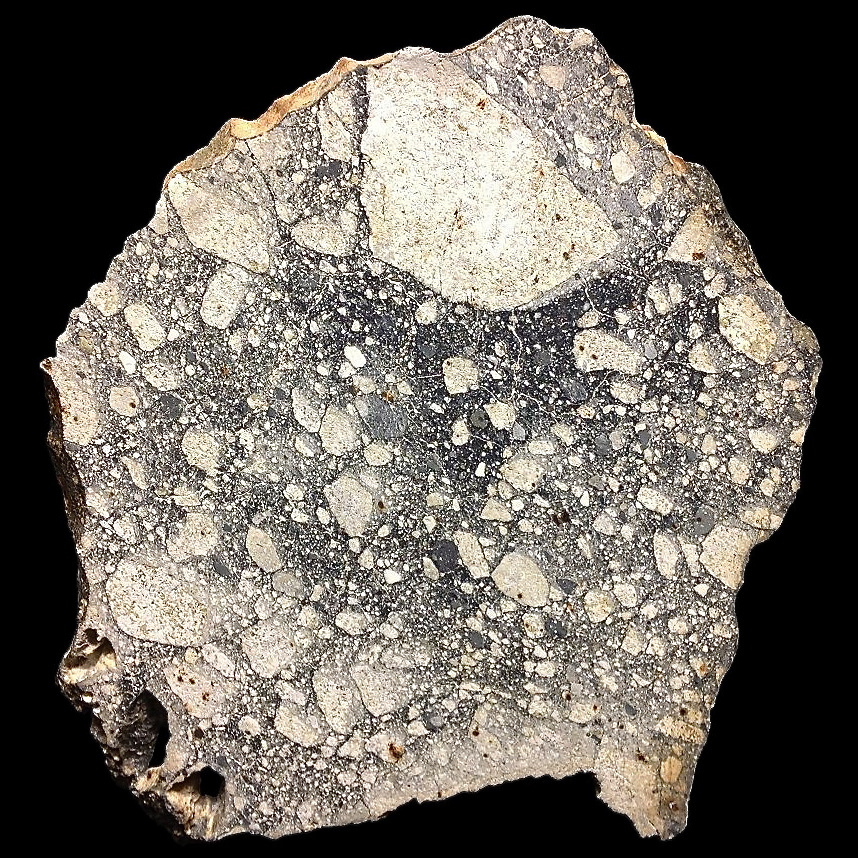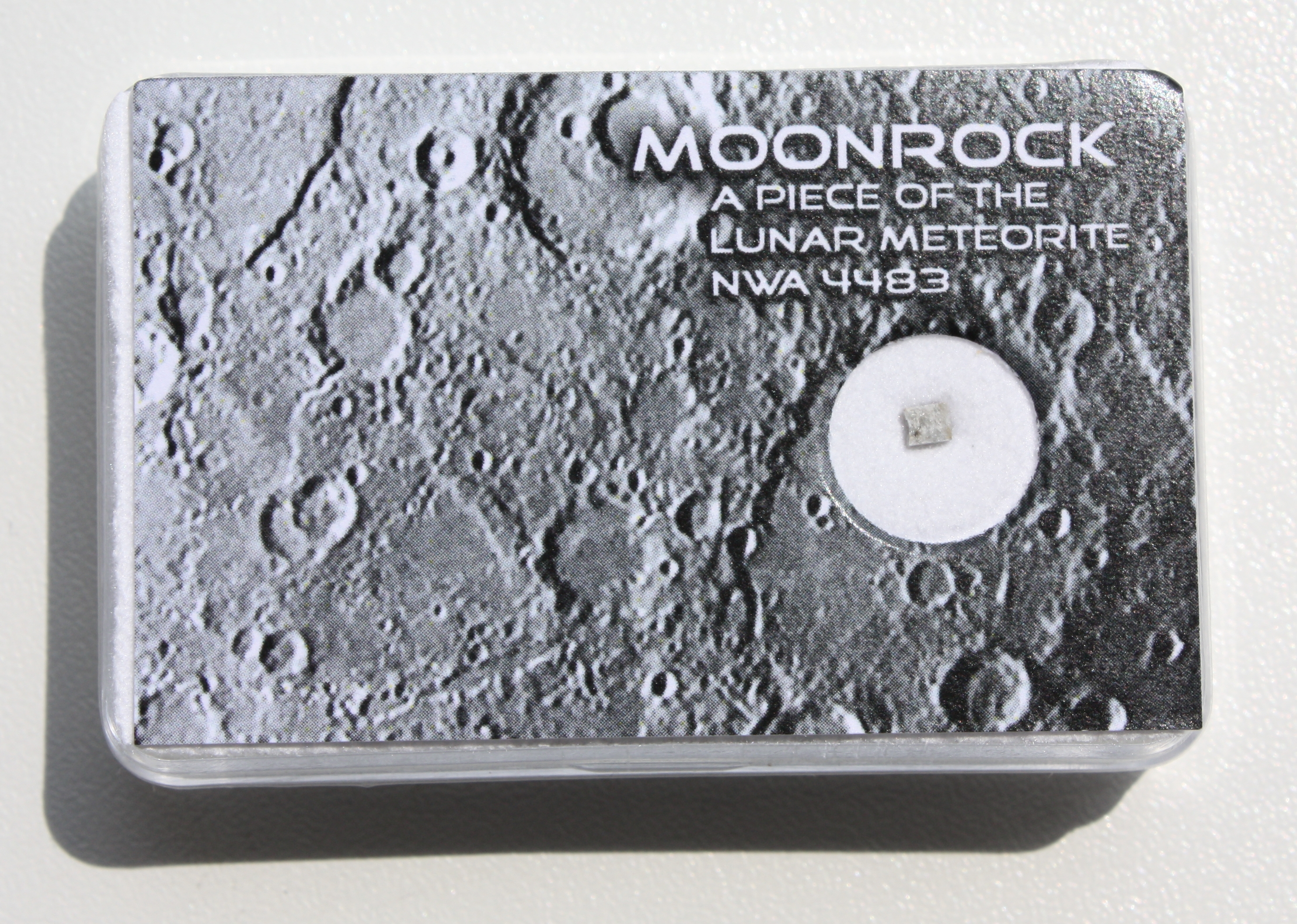Lunar meteorite on:
[Wikipedia]
[Google]
[Amazon]
 A lunar meteorite is a meteorite that is known to have originated on the
A lunar meteorite is a meteorite that is known to have originated on the
 Lunar meteorites collected in Africa and Oman are, for all practical purposes, the only source of moon rocks available for private ownership. This is because all rocks collected during the
Lunar meteorites collected in Africa and Oman are, for all practical purposes, the only source of moon rocks available for private ownership. This is because all rocks collected during the
Lunar Meteorites
List of Lunar MeteoritesLunar Meteorites
Lunar meteorite articles in Planetary Science Research Discoveries
{{DEFAULTSORT:Lunar Meteorite
 A lunar meteorite is a meteorite that is known to have originated on the
A lunar meteorite is a meteorite that is known to have originated on the Moon
The Moon is Earth's only natural satellite. It is the fifth largest satellite in the Solar System and the largest and most massive relative to its parent planet, with a diameter about one-quarter that of Earth (comparable to the width of ...
. A meteorite hitting the Moon is normally classified as a transient lunar phenomenon
A transient lunar phenomenon (TLP) or lunar transient phenomenon (LTP) is a short-lived light, color or change in appearance on the surface of the Moon. The term was created by Patrick Moore in his co-authorship of NASA Technical Report R-277 ''C ...
.
Discovery
In January 1982, John Schutt, leading an expedition inAntarctica
Antarctica () is Earth's southernmost and least-populated continent. Situated almost entirely south of the Antarctic Circle and surrounded by the Southern Ocean, it contains the geographic South Pole. Antarctica is the fifth-largest cont ...
for the ANSMET
ANSMET (Antarctic Search for Meteorites) is a program funded by the Office of Polar Programs of the National Science Foundation that looks for meteorites in the Transantarctic Mountains. This geographical area serves as a collection point for met ...
program, found a meteorite that he recognized to be unusual. Shortly thereafter, the meteorite now called Allan Hills 81005 was sent to Washington, DC, where Smithsonian Institution
The Smithsonian Institution ( ), or simply the Smithsonian, is a group of museums and education and research centers, the largest such complex in the world, created by the U.S. government "for the increase and diffusion of knowledge". Founded ...
geochemist
Geochemistry is the science that uses the tools and principles of chemistry to explain the mechanisms behind major geological systems such as the Earth's crust and its oceans. The realm of geochemistry extends beyond the Earth, encompassing the e ...
Brian Mason recognized that the sample was unlike any other known meteorite and resembled some rocks brought back from the Moon
The Moon is Earth's only natural satellite. It is the fifth largest satellite in the Solar System and the largest and most massive relative to its parent planet, with a diameter about one-quarter that of Earth (comparable to the width of ...
by the Apollo program. Several years later, Japanese scientists recognized that they had also collected a lunar meteorite, Yamato 791197, during the 1979 field season in Antarctica
Antarctica () is Earth's southernmost and least-populated continent. Situated almost entirely south of the Antarctic Circle and surrounded by the Southern Ocean, it contains the geographic South Pole. Antarctica is the fifth-largest cont ...
. , 371 lunar meteorites have been discovered, perhaps representing more than 30 separate meteorite falls (i.e., many of the stones are "paired" fragments of the same meteoroid
A meteoroid () is a small rocky or metallic body in outer space.
Meteoroids are defined as objects significantly smaller than asteroids, ranging in size from grains to objects up to a meter wide. Objects smaller than this are classified as mi ...
). The total mass is more than . All lunar meteorites have been found in deserts; most have been found in Antarctica
Antarctica () is Earth's southernmost and least-populated continent. Situated almost entirely south of the Antarctic Circle and surrounded by the Southern Ocean, it contains the geographic South Pole. Antarctica is the fifth-largest cont ...
, northern Africa
Africa is the world's second-largest and second-most populous continent, after Asia in both cases. At about 30.3 million km2 (11.7 million square miles) including adjacent islands, it covers 6% of Earth's total surface area ...
, and the Sultanate of Oman
Oman ( ; ar, عُمَان ' ), officially the Sultanate of Oman ( ar, سلْطنةُ عُمان ), is an Arabian country located in southwestern Asia. It is situated on the southeastern coast of the Arabian Peninsula, and spans the mouth of t ...
. None have yet been found in North America, South America, or Europe.
Lunar origin is established by comparing the mineralogy, the chemical composition, and the isotopic composition between meteorites and samples from the Moon collected by Apollo
Apollo, grc, Ἀπόλλωνος, Apóllōnos, label=genitive , ; , grc-dor, Ἀπέλλων, Apéllōn, ; grc, Ἀπείλων, Apeílōn, label= Arcadocypriot Greek, ; grc-aeo, Ἄπλουν, Áploun, la, Apollō, la, Apollinis, label ...
missions.
Transfer to Earth
Most lunar meteorites are launched from the Moon by impacts making lunar craters of a few kilometers in diameter or less. No source crater of lunar meteorites has been positively identified, although there is speculation that the highly anomalous lunar meteorite Sayh al Uhaymir 169 derives from the Lalande impact crater on the lunar nearside. Cosmic-ray exposure history established with noble-gas measurements have shown that all lunar meteorites were ejected from the Moon in the past 20 million years. Most left the Moon in the past 100,000 years. After leaving the Moon, most lunar meteoroids go into orbit around Earth and eventually succumb to Earth's gravity. Some meteoroids ejected from the Moon get launched into orbits around the Sun. These meteoroids remain in space longer, but eventually intersect the Earth's orbit and land.Scientific relevance
All six of the Apollo missions on which samples were collected landed in the central nearside of the Moon, an area that has subsequently been shown to be geochemically anomalous by the Lunar Prospector mission. In contrast, the numerous lunar meteorites are random samples of the Moon and consequently provide a more representative sampling of the lunar surface than the Apollo samples. Half the lunar meteorites, for example, likely sample material from the farside of the Moon. At the time the first meteorite from the Moon was discovered in 1982, there was speculation that some other unusual meteorites that had been found previously originated from Mars. The positive identification of lunar meteorites on Earth supported the hypothesis that meteoroid impacts on Mars could eject rocks from that planet. There are also speculations about the possibility of finding "Earth meteorites" on the surface of the Moon. This would be very interesting because in this case stones from Earth older than 3.9 billion years, which are destroyed on Earth by various geological processes, may have survived on the Moon. Thus some scientists propose new missions to the Moon to search for ancient rocks fromEarth
Earth is the third planet from the Sun and the only astronomical object known to harbor life. While large volumes of water can be found throughout the Solar System, only Earth sustains liquid surface water. About 71% of Earth's surfa ...
.
Observation history
About one in every thousand newly discovered meteorites is a lunar meteorite, whereas the vast majority of meteorites are from the asteroid belt. In the early 19th century most scientists believed that all meteorites falling towards the Earth were from the Moon. Although today supported only by a minority of researchers, there are also theories thattektite
Tektites (from grc, τηκτός , meaning 'molten') are gravel-sized bodies composed of black, green, brown or grey natural glass formed from terrestrial debris ejected during meteorite impacts. The term was coined by Austrian geologist Franz ...
s are from the Moon and should therefore also be regarded as lunar meteorites. However, most scientists regard such theories as outdated.
Private ownership
 Lunar meteorites collected in Africa and Oman are, for all practical purposes, the only source of moon rocks available for private ownership. This is because all rocks collected during the
Lunar meteorites collected in Africa and Oman are, for all practical purposes, the only source of moon rocks available for private ownership. This is because all rocks collected during the Apollo
Apollo, grc, Ἀπόλλωνος, Apóllōnos, label=genitive , ; , grc-dor, Ἀπέλλων, Apéllōn, ; grc, Ἀπείλων, Apeílōn, label= Arcadocypriot Greek, ; grc-aeo, Ἄπλουν, Áploun, la, Apollō, la, Apollinis, label ...
moon-landing program are property of the United States government or of other nations to which the U.S. conveyed them as gifts. Similarly, all lunar meteorites collected by the U.S. and Japanese Antarctic programs are, by treaty, held by those governments for research and education purposes only. Although there is no U.S. law specifically against the ownership of Apollo moonrocks, none has ever been (or is likely to ever be) given or sold by the U.S. government to private citizens. Even in the cases of plaques containing genuine Apollo moonrocks given in 2004 to astronauts and Walter Cronkite
Walter Leland Cronkite Jr. (November 4, 1916 – July 17, 2009) was an American broadcast journalist who served as anchorman for the ''CBS Evening News'' for 19 years (1962–1981). During the 1960s and 1970s, he was often cited as "the mo ...
, NASA retained ownership of the rocks themselves. Most of the moonrocks collected by the Luna 16
''Luna 16'' was an uncrewed space mission, part of the Soviet Luna program. It was the first robotic probe to land on the Moon and return a sample of lunar soil to Earth. The 101 grams (3.56 ounces) sample was returned from Mare Fecunditatis. ...
probe are also unavailable for private ownership, although three tiny samples were sold at auction for $442,500 in 1993.
See also
*Glossary of meteoritics
This is a glossary of terms used in meteoritics, the science of meteorites.
#
* 2 Pallas – an asteroid from the asteroid belt and one of the likely parent bodies of the CR meteorites.
* 4 Vesta – second-largest asteroid in the asteroid b ...
* Geology of the Moon
The geology of the Moon (sometimes called selenology, although the latter term can refer more generally to " lunar science") is quite different from that of Earth. The Moon lacks a true atmosphere, which eliminates erosion due to weather. It does ...
* List of lunar meteorites
* List of meteorites on Mars
This is an alphabetical list of named rocks (and meteorites) found on Mars, by mission. This list is a sampling of rocks viewed, and is not an exhaustive listing. A more complete listing may be found on the various NASA mission web sites. This lis ...
* Martian meteorite
A Martian meteorite is a rock that formed on Mars, was ejected from the planet by an impact event, and traversed interplanetary space before landing on Earth as a meteorite. , 277 meteorites had been classified as Martian, less than half a percen ...
* Moon rocks
Moon rock or lunar rock is rock originating from Earth's Moon. This includes lunar material collected during the course of human exploration of the Moon, and rock that has been ejected naturally from the Moon's surface and landed on Earth as ...
References
Scientific reference
*General references
* *External links
Lunar Meteorites
Washington University in St. Louis
Washington University in St. Louis (WashU or WUSTL) is a private research university with its main campus in St. Louis County, and Clayton, Missouri. Founded in 1853, the university is named after George Washington. Washington University is r ...
List of Lunar Meteorites
University of Arizona
The University of Arizona (Arizona, U of A, UArizona, or UA) is a public land-grant research university in Tucson, Arizona. Founded in 1885 by the 13th Arizona Territorial Legislature, it was the first university in the Arizona Territory.
T ...
Lunar meteorite articles in Planetary Science Research Discoveries
{{DEFAULTSORT:Lunar Meteorite